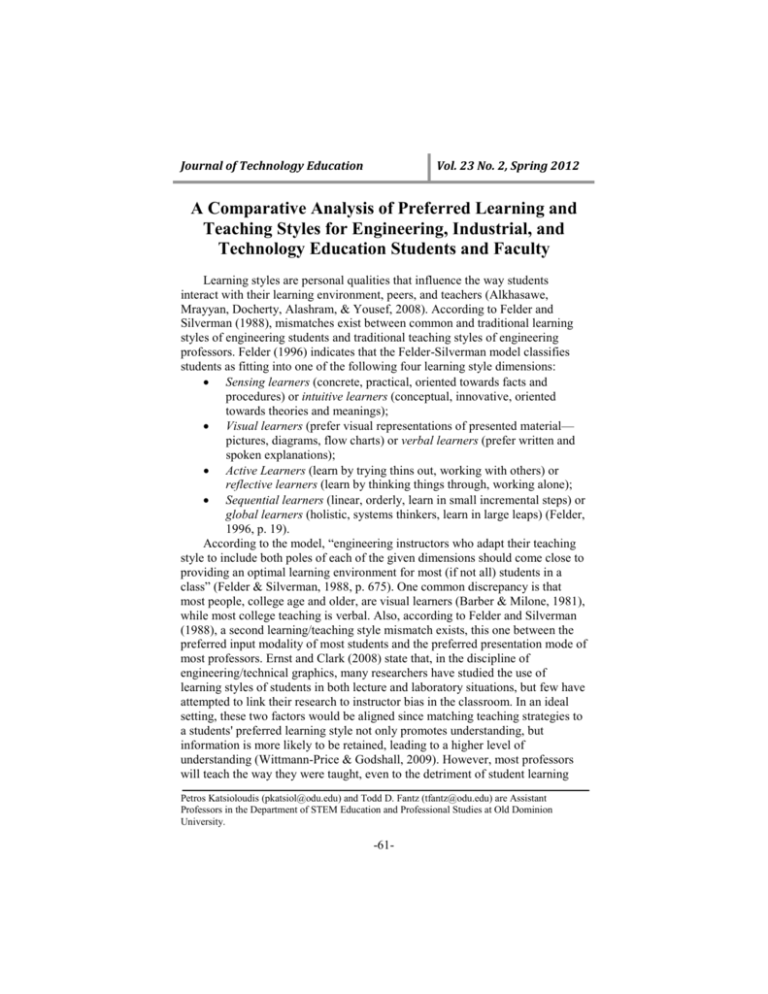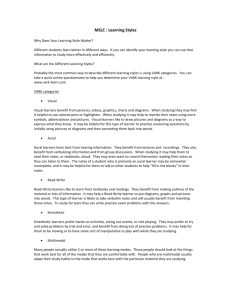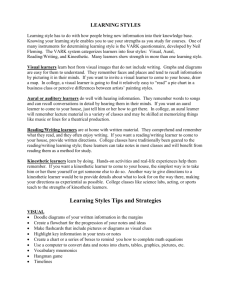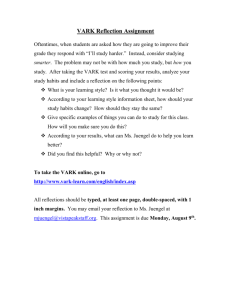JTE v23n2 - A Comparative Analysis of Preferred Learning and
advertisement

Journal of Technology Education Vol. 23 No. 2, Spring 2012 A Comparative Analysis of Preferred Learning and Teaching Styles for Engineering, Industrial, and Technology Education Students and Faculty Learning styles are personal qualities that influence the way students interact with their learning environment, peers, and teachers (Alkhasawe, Mrayyan, Docherty, Alashram, & Yousef, 2008). According to Felder and Silverman (1988), mismatches exist between common and traditional learning styles of engineering students and traditional teaching styles of engineering professors. Felder (1996) indicates that the Felder-Silverman model classifies students as fitting into one of the following four learning style dimensions: • Sensing learners (concrete, practical, oriented towards facts and procedures) or intuitive learners (conceptual, innovative, oriented towards theories and meanings); • Visual learners (prefer visual representations of presented material— pictures, diagrams, flow charts) or verbal learners (prefer written and spoken explanations); • Active Learners (learn by trying thins out, working with others) or reflective learners (learn by thinking things through, working alone); • Sequential learners (linear, orderly, learn in small incremental steps) or global learners (holistic, systems thinkers, learn in large leaps) (Felder, 1996, p. 19). According to the model, “engineering instructors who adapt their teaching style to include both poles of each of the given dimensions should come close to providing an optimal learning environment for most (if not all) students in a class” (Felder & Silverman, 1988, p. 675). One common discrepancy is that most people, college age and older, are visual learners (Barber & Milone, 1981), while most college teaching is verbal. Also, according to Felder and Silverman (1988), a second learning/teaching style mismatch exists, this one between the preferred input modality of most students and the preferred presentation mode of most professors. Ernst and Clark (2008) state that, in the discipline of engineering/technical graphics, many researchers have studied the use of learning styles of students in both lecture and laboratory situations, but few have attempted to link their research to instructor bias in the classroom. In an ideal setting, these two factors would be aligned since matching teaching strategies to a students' preferred learning style not only promotes understanding, but information is more likely to be retained, leading to a higher level of understanding (Wittmann-Price & Godshall, 2009). However, most professors will teach the way they were taught, even to the detriment of student learning Petros Katsioloudis (pkatsiol@odu.edu) and Todd D. Fantz (tfantz@odu.edu) are Assistant Professors in the Department of STEM Education and Professional Studies at Old Dominion University. -61- Journal of Technology Education Vol. 23 No. 2, Spring 2012 (Sadowski, Birchman, & Harris, 2005). According to Bastable (2008), information that is delivered in a style that matches the students' learning style promotes understanding that leads to the retention of new information at a conceptual level, versus surface learning that only requires memorization (Wittmann-Price & Godshall, 2009). On the other side, discounting learning styles can lead to bored, unresponsive class participants, which in turn effect grades and attendance rates, therefore, leading to a loss in satisfaction (Alkhasaweh et al., 2008). Learners make the most out of information when they can select information and organize it into representations that make sense to them (Jonassen, 1999; Mayer & Moreno, 1998; Mayer, 1996; Mayer, 1999b; Wittrock, 1990). To address this identified need, a study was conducted to examine the alignment of students’ preferred learning styles with instructor’s teaching style in a materials process course. Instrumentation: The VARK Questionnaire The VARK Questionnaire was used in this study to assess the preferred learning styles of university students enrolled in a materials process course. The questionnaire is employed to determine to what extent, what percentage of, the students’ preferred style is visual, aural, read/write, or kinesthetic. In 1987, Neil Fleming of Lincoln University, New Zealand developed the VARK Questionnaire. It diverges from the majority of learning styles instruments in that its principal intent is to be consultative rather than pointing and prognostic. The major additive component that separates the VARK Questionnaire from other preferred learning style advisories is the fourth category, read-write (Fleming, 2006). Methodology In the spring semester of 2010, a materials process course was selected as a means to perform a preferred learning style research study. This course was selected because it contained three groups of students: technology education, engineering technology, and industrial technology. The researchers believed that the differences in the students’ background and program emphasis would lead to interesting results. The study’s goal was to identify students’ preferred learning style according to major and then compare it with the teaching style of the faculty members that have taught the course in the last five years. All three groups of students were enrolled in a materials process course. This course introduced the students to basic content and skills needed to process common materials and produce functional products using woods, metals, plastics, and composite materials. This course also included laboratory safety, use of hand tools, and operation of machinery. Course content was reiterated to students through laboratory discovery experiences in materials testing and construction of multi-material projects. Pedagogy and learning outcomes were based on the creation and demonstration of physical products. The two research questions that guided this study were: -62- Journal of Technology Education Vol. 23 No. 2, Spring 2012 1. Is there a difference in the preferred learning style of students in a materials process course according to their academic major? 2. Does the faculty use instructional methods that align with the students’ preferred learning styles in a materials process course? The VARK Questionnaire was distributed to the student groups about midway through the spring semester of 2010. The willing student participants (n = 37) completed the VARK Questionnaire, and instructors collected and returned the questionnaires to the researchers. The faculty members who were currently teaching the course, or who have previously taught the course (n = 8), were given descriptions of each type of learning style: visual, aural, read/write, and kinesthetic. The faculty members were then asked to reflect back on their methods of teaching the course and estimate what percentage of instructional class time was spent teaching within each style. For example, an instructor may report 70% of the instructional time was spent on kinesthetic tasks, 10% on visual, 10% on aural, and the remaining 10% on read/write. Data Analysis Analysis of the data began with generating summary statistics of the mean score within each learning style for the student sample. As shown in Table 1, the mean scores for each learning style were segregated by major. The predominant learning style is the largest number compared to the other learning styles and is shown in bold in Table 1. The same data is visually represented and grouped based on learning style in Figure 1. The percentage of each learning style’s contribution to the sum total of all the learning styles is also shown in Table 1. Table 1 Mean VARK Score as a Function of Declared Major Major Engineering Technology Industrial Technology Technology Education Average Percentage of Total N 11 Visual 5.91 Aural 6.45 Read/Write 5.64 Kinesthetic 6.36 9 6.22 5.89 4.44 6.33 17 6.76 6.35 7.53 8.24 6.30 24.8% 6.23 24.5% 5.87 23.2% 6.98 27.5% -63- Journal of Technology Education Vol. 23 No. 2, Spring 2012 Figure 1 Mean VARK Score as a Function of Declared Major 9 8 7 6 5 Engineering Technology 4 3 Industrial Technology 2 Technology Education 1 0 Research Question 1 Due to the non-normality of the data set, non-parametric statistics were used to explore for any significant differences between the groups and their preferred learning styles. A Kruskal-Wallis test was used to develop a mean rank score for each learning style based on academic major. The mean rank score results are shown in Table 2. The mean rank scores were then used in the KruskalWallis test to explore for statistically significant differences between majors for each learning style. The results of this test are shown in Table 3. Table 2 Mean Rank VARK Score as a Function of Declared Major Major N Visual Aural Read/Write Kinesthetic Engineering Technology Industrial Technology Technology Education Average 11 17.55 20.05 17 15.95 9 18.72 17.67 12.83 15.67 17 20.09 19.03 23.56 22.74 18.79 18.92 17.80 18.12 -64- Journal of Technology Education Vol. 23 No. 2, Spring 2012 Table 3 Kruskal-Wallis Test of VARK Difference as a Function of Declared Major Visual Engineering Technology Industrial Technology Technology Education Mean Rank 17.55 18.72 20.09 Aural Engineering Technology Industrial Technology Technology Education 20.05 17.67 19.03 Read/Write Engineering Technology Industrial Technology Technology Education 17.00 12.83 23.56 Kinesthetic Engineering Technology Industrial Technology Technology Education * Denotes Statistical Significance 15.95 15.67 22.74 ChiSquare 0.383 df Sig. 2 0.826 0.243 2 0.885 6.379 2 0.041* 3.810 2 0.149 Statistical differences that resulted from the Kruskal-Wallis test are designated with an asterisk next to the significance value. A pre-determined significant level, α, of 0.05 was used as a significance threshold. The only learning style that achieved statistical significance was the Read/Write learning style with a mean rank of 23.56 for Technology Education students and a mean rank of 12.83 for the Industrial Technology students. Overall, there is not much variation between any of the groups within each learning style. In response to Research Question 1, is there a difference in the preferred learning style of students in a materials process course according to their academic major, we conclude that the only difference is between the technology education students and the industrial technology students within the read/write learning style. Research Question 2 All faculty who have taught the materials process course in the last five years agreed to participate in this study (n = 8). Via an online survey instrument, faculty members were given descriptions of each type of learning style and -65- Journal of Technology Education Vol. 23 No. 2, Spring 2012 asked what percentage of their instructional time was spent on each style. The results of the faculty survey are shown in Table 4. Table 4 Use of VARK Methods by Faculty N Faculty 8 Percentage of Time Spent Teaching in Each Style Visual Aural Read/Write Kinesthetic 15 28.75 21.25 37.5 The faculty report an emphasis on the kinesthetic learning style with nearly 40% of their instruction time spend on a kinesthetic type of pedagogy. On the other end, the visual learning style is the least represented pedagogy in the faculty’s presentation of material. To compare the composite class learning style with the pedagogical methods used by instructors, a percentage of the average preferred learning style of the students was calculated, as shown in Table 1. A comparison of the methods used by faculty and the preferred learning style of students is shown in Table 5. In addition, the difference in percentages between the faculty and students preferred learning styles are also shown in Table 5. A negative difference indicates that faculty are short in the allocation of the amount of time needed for that learning preference to target the courses’ learning style needs. A positive difference indicates an excess of time spent with that learning style based on the courses preferred learning style makeup. Table 5 VARK Methods by Faculty and Preferred Methods by Students Faculty Students Difference (Faculty-Students) Visual 15% 24.8% -9.8% Percentage of Time in Each Style Aural Read/Write Kinesthetic 28.75% 21.25% 37.5% 24.5% 23.2% 27.5% 4.25% -1.95% 10% While the instructional methods of the faculty are dominant in the kinesthetic style, and the students’ dominant preferred learning style is also kinesthetic, the faculty spend about 10% more time within the style than the overall student learning style suggests. Addressing Research Question 2, does the faculty use instructional methods that align with the students’ preferred -66- Journal of Technology Education Vol. 23 No. 2, Spring 2012 learning styles in a materials process course, the researchers conclude that, while the faculty’s percentage of time is close to aligning with the students’ preferred learning style make-up, less emphasis on the kinesthetic style and more emphasis on the visual style would lead to an optimal match. Conclusions and Recommendations This study showed that while there was some variation within majors, the overall dominant learning style in the materials process course was the kinesthetic style. While this was a result the researchers expected, the technology education students were unexpected outliers from the rest of the group. From the Kruskal and Wallis test, the researchers observed a statistical significance (0.041*) between the three groups for the read/write learning style with the technology education students rating it the most preferred learning style. This does raise additional questions for researchers. Based on how the curriculum is often developed and delivered, technology education is typically a very hands-on, kinesthetic discipline. In fact, the content is more kinesthetically based than industrial technology and engineering technology programs, yet students from these other disciplines rated kinesthetic learning as more important than the technology education students. Further research is needed to determine if technology education as a discipline should shift a little more toward the read/write delivery method, sacrificing some of the kinesthetic teaching in the process. These results could also be due to the grass being greener on the other side of the fence. As engineering technology and industrial technology students do not have as much kinesthetic-based learning in their programs, they may see it as a better, more preferred, option of getting content. The same may be true of technology education students believing more read/write-based curriculum would be beneficial. The researchers suggest that the current data-base of student preferred learning styles be continued as additional sections of the course are taught. The number of industrial technology students (n = 9) and engineering technology students (n = 11) in the data-base were low compared to that of technology education (n = 17). The researchers also plan to review additional courses that contain all three academic majors to determine if this course is representative of the programs in general. In addition, the researchers are interested in further exploring the preferred teaching style of faculty. According to the study, the dominant preferred teaching style of the faculty members who taught the materials process course (n = 8) was the kinesthetic style. The researchers suggest that this is due to the learning style and comfort zone of the faculty. In essence, faculty members are teaching the way they were taught. Further research is needed to determine how willing faculty members are to teach outside their comfort level to match the students’ preferred learning styles. -67- Journal of Technology Education Vol. 23 No. 2, Spring 2012 While conducting the literature reviews to better focus this research, it was determined that there was a lack of research undertaken on cognitive technical learning. The researchers would like to thank our colleagues who have worked on studying the design process, problem solving in technology, and technical thinking. More needs to be done in these areas so that the added value of technical learning is determined and used to better promote our school subject. By understanding the learning style make-up of the students enrolled in their courses, faculty should be able to adjust their modes of content delivery to match student preferences and maximize student learning. References Alkhasaweh, I. M., Mrayyan, M. T., Docherty, C, Alashram, S., & Yosef, H. (2008). Problem-based learning (PBL): Assessing students' learning preferences using VARK. Nurse Education Today, 28, 572-579. Bastable, S. B. (2008). Nurse as educator: Principles of teaching and learning for nursing practice (3rd ed.). Boston: Jones and Bartlett Publishers. Barbe, W. B., & Milone, M. N. (1981). What We Know About Modality Strengths. Educational Leadership, 70 (1), 378-380. Ernst, J, & Clark, A. (2008). Students’ Preferred Learning Styles in Graphic Communications. Engineering Design Graphics Journal, 72(1), 9-18. Felder, R. M., & Silverman, L. K. (1988). Learning and teaching styles in engineering education [Electronic Version]. Engr. Education, 78(7), 674681. Retrieved on March 27th, 2012 from: http://www4.ncsu.edu./unity/lockers/users/f/felder/public/Papers/LS1988.pdf Felder, R. M. (1996). Matters of style [Electronic Version]. ASEE Prism 6(4), 18-23. Retrieved on March 27th, 2012 from: http://www4.ncsu.edu/unity/lockers/users/f/felder/public/Papers/LSPrism.htm Fleming, N. D. (1995). I’m different; not dumb. Modes of presentation (VARK) in the tertiary classroom, in Zelmer, A., (ed.) Research and Development in Higher Education, Proceedings of the 1995 Annual Conference of the Higher Education and Research Development Society of Australasia (HERDSA),HERDSA, Volume 18, pp. 308 – 313. Fleming, N. D. (2006). VARK: A guide to learning styles. Retrieved March 24, 2007, from http://www.vark-learn.com/english/page.asp?p=advice Mayer, R. E. (1996). Multimedia learning: Are we asking the right questions? Educational Psychologist, 32, 1–19. Mayer, R. E. (1999). Multimedia aids to problem-solving transfer. International Journal of Educational Research 31,661–624. -68- Journal of Technology Education Vol. 23 No. 2, Spring 2012 Sadowski, M. A., Birchman, J. A., & Harris, L. V. (2005). An assessment of graphics faculty and student learning styles. Published Proceedings from the American Society for Engineering Education Annual Conference and Exposition. Portland, OR. Jonassen, D. (1999). Designing Constructivist Learning Environments. In C. M. Reigeluth (Ed.), Instructional-design theories and models: Vol. II. A new paradigm of instructional theory (pp. 215-239). Mahwah, NJ: Lawrence Erlbaum Associates. Mayer, R. E., & Moreno, R. (1998). A split-attention affect in multimedia learning: Evidence for dual processing systems in working memory. Journal of Educational Psychology, 90, 312–320. Wittrock, M. C. (1990). Generative processes in reading comprehension. Educational Psychologist, 24, 345-376. Wittmann-Price, R. A., & Godshall, M. (2009). Strategies to promote deep learning in clinical nursing courses. Nurse Educator, 34(5), 214-216. -69-





